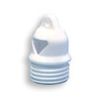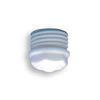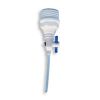Geotech 1" FEP Reusable Bailers
Features
- Available with a complete set of mix-and-match interchangeable components
- Ideal in all groundwater sampling applications
- Increased versatility with point source tops and controlled flow bottoms
- Expedited repair and warranty service
- Lifetime technical support
- More
Overview
The Geotech 1" FEP reusable sampling bailers are made of chemically inert, 100% virgin fluoropolymer resin. Bailers are available with a complete set of mix-and-match interchangeable components, making them ideal for all groundwater sampling applications.
Design
The opening is V-notched for accurate pouring. The rounded thread design allows easy, complete cleaning. The standard bailer body is 1 3/4" and is available in 1 ft., 2 ft. and 3 ft. lengths. Bailers are also available in 3/4" and 1" O.D. for use in 1", 1 3/4" or 1" diameter wells. The precision ground check valve stays confined to the bottom section to prevent loss. The special seat design prevents leakage and premature opening when emptying.
Mechanics
The Point Sampling top offers an added check valve that isolates samples taken at specific depths. The Controlled Flow Bottom controls the flow rate from slow drip to rapid empty. High-speed Sample Transfer Devices are available in several configurations.
In The News
Safeguarding Communities with Real-Time Flood Monitoring in the City of Hazelwood
The City of Hazelwood is a suburb in St. Louis County, Missouri, home to around 25,500 people. Recently, the community has suffered increased flash flooding following severe storms, prompting the need for the installation of a flood monitoring system. In 2022, a NexSens X2 data logger was installed to monitor water level and rainfall in real-time, with the aim of reducing the loss of life and property as a result of extreme weather events. [caption id="attachment_39411" align="alignnone" width="940"] The latest flood event at Coldwater Creek, where the water level rose by 14 feet, exceeding the height of the X2 by three feet. The sensor can be seen behind the wall that usually contains the Creek.
Read MoreSave our Bogs! Culture, Conservation and Climate Action in Ireland’s Peatlands
Characterized by long-term accumulation under waterlogged conditions, peatlands exist on every continent and account for 3-4% of the global land surface . Small but mighty, these often overlooked wetland environments are estimated to hold as much as one-third of the world's organic carbon in their soil—twice the amount found in the entirety of the Earth's forest biomass. While healthy peatlands can trap and store carbon, regulate water, and provide important habitats for rare species, human alteration has disturbed peatland carbon and nitrogen cycles on a global scale. Approximately 12% of the world’s peatlands have been drained and degraded through conversion for agriculture, forestry, infrastructure development, and other uses.
Read MoreSargassum Surge: How Seaweed is Transforming our Oceans and Coastal Ecosystems
Until recently, Sargassum –a free-floating seaweed–was distributed throughout the Sargasso Sea , the north Caribbean Sea, and the Gulf of Mexico. But in the space of a decade, this seaweed has, as one scientist remarks , “Gone from a nonfactor to the source of a terrible crisis.” Driven by climate change, anomalous North Atlantic Oscillation in 2009-2010 and a glut of anthropogenic pollutants, sargassum has proliferated. Seasonally recurrent mats as deep as 7m now bloom in the “Great Atlantic Sargassum Belt” (GASB), which covers areas of the Atlantic from West Africa to the Caribbean Sea and Gulf of Mexico. Every year, millions of tons wash up along the shores of more than 30 countries . Dr.
Read More





















